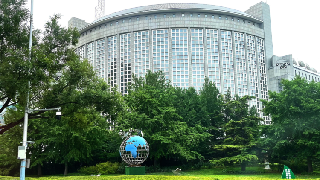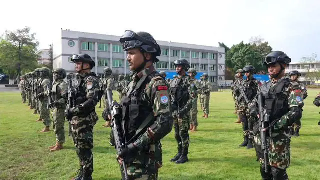By Wu Minwen
吴敏文
The Japanese Defense Ministry announced its 2025 defense budget – 8.5 trillion Yen – on August 30, a new record after years of continuous increase. The marked changes in Japan's defense policy in recent years have cast a cloud over the regional situation.
8月30日,日本防卫省公布2025年防卫费预算为8.5万亿日元,这是日本防卫费连续多年增长后,年度防卫费预算再创新高。近年来,日本防卫政策发生显著变化,给地区局势投下浓重阴霾。
Japan, a losing party in WWII, has been obliged to keep its annual defense expenditure under 1% of GDP under pressure from the international community and the restrictions imposed by its own Pacifist Constitution. However, for some time now, Japan, for various reasons, has been trying to break the restrictions on its military development and defense spending and challenge the post-WWII international order. The three new defense policies released by Tokyo in December 2022 marked Japan's major about-face and a dangerous belligerent inclination.
作为二战战败国的日本,受到国际社会以及日本和平宪法的限制,年度防卫费投入一直低于GDP的1%。但是,一段时间以来,由于各种原因,在武装力量发展和防卫费投入上,日本逐渐实际突破和平宪法的约束,挑战二战后奠定的国际秩序。2022年12月,日本政府发布新的防务政策三文件,这显示日本防卫政策开始发生重大改变,呈现出危险的好战倾向。
To implement the new defense policies, Japan has rolled out a number of projects regarding the establishment of defense systems and mechanisms, strengthening military research, increasing weapon and ammunition stockpiles, and reinforcing battlefield construction. According to the National Security Strategy of 2022, the JSDF Joint Operations Command (JJOC) will be formed under the Defense Ministry which will command the operating troops and coordinate with the US Indo-Pacific Command.
为了落实新的防卫政策,日本从防务体制机制建设,到加强军事科研和武器弹药储备、进行战场建设等方面,都增加了大量建设项目。依据2022年的新版《国家安全保障战略》,日本在防卫省下属设立统合司令部,成为具有作战指挥权的指挥机构,并与美国印太司令部对接。
Moreover, Japan also has a "missile wall" program that involves commissioning 1,000 medium- and long-range missiles, plans to buy 105 F-35 fighters and 8 US-made MQ-9 Reaper strategic UAVs, and moves to enhance its military deployments in the southwestern direction, covering situation awareness, air defense early warning, and the stationing of JSDF troops. Implementing these programs and plans is bound to increase military expenditure.
另外,日本新防务政策的落实,还包括列装1000枚中远程导弹的“导弹墙”计划,采购105架F-35战机,采购8架美国产MQ-9“死神”战略无人机,以及加强在其西南方向的态势感知、防空预警、自卫队力量进驻等军事部署,完成这些项目和计划都必将增加经费投入。
The shift in Japan's defense policy and its reinforced military moves are set against the background of America's promotion of its "Indo-Pacific strategy", for which the US needs Japan to play a bigger role in containing China. Therefore, Japan has not only followed the US in wantonly exaggerating the "China threat", but also made all-out efforts to leverage and cater to America's strategic needs to strengthen its own command system and military capabilities.
日本的防务政策转向和加强,背景是利用美国实施“印太战略”,在遏制中国方面需要日本扮演更加重要的角色。为此,日本不仅紧随美国大肆渲染“中国威胁论”,而且在指挥体制加强、军事力量发展方面,也全面借力和迎合美国的战略需求。
First, it has worked hard to align the command systems of the US Forces Japan (USFJ) and JSDF. The US connives in and even encourages Japan's establishment of the JJOC in order to incorporate JSDF into its own combat system. At the US-Japan "2+2" foreign and defense ministers' meeting on July 28 this year, the US side announced to convert the USFJ into a joint force headquarters, which, though still part of the Indo-Pacific Command, will assume combat commanding functions. At times of war, the USFJ joint force headquarters and JSDF's JJOC will communicate directly to jointly command the two forces. US Defense Secretary Austin called this "the most significant change to U.S. Forces Japan since its creation, and one of the strongest improvements in our military ties with Japan in 70 years".
一是紧密对接驻日美军和日本自卫队指挥体制。美国放手、鼓励纵容日本成立统合司令部,是因为美国需要利用统合司令部,将日本自卫队纳入美军作战体系。今年7月28日,美日举行外交安全“2+2”会议,宣布将驻日美军司令部升格为“联合部队总部”,虽仍然隶属印太司令部,但增加了作战指挥职能。在战争条件下,美军驻日联合部队总部与日本自卫队统合司令部直接对接,统一指挥驻日美军和日本自卫队。美国国防部长奥斯汀将此举称为“美军驻日以来最重大的变化”和“70年来美日军事合作最重要的升级”。
Second, it hopes to tighten the US-Japan bond through AUKUS. When Japanese Prime Minister Fumio Kishida visited Washington on April 10 this year, Biden announced the official inclusion of Japan into AUKUS, calling the nuclear submarine cooperation among the US, the UK and Australia the "pillar 1" of AUKUS, while "pillar 2", formed with Japan's joining, covered AI, quantum technology, advanced network, hypersonic technology, underwater combat, UAV, and electronic warfare.
二是利用“奥库斯”将美日更紧密捆绑。今年4月10日,在日本首相岸田文雄访问华盛顿之际,拜登宣布“奥库斯”正式吸纳日本加入,并将美、英、澳三方的核潜艇生产合作界定为“奥库斯”的“第一支柱”,日本加入“奥库斯”的“第二支柱”包括人工智能、量子技术、先进网络、高超音速技术、水下战争、无人机以及电子战等项目。
America is using AUKUS to tie Japan more tightly to its chariot and using Japan's resources to develop its own and its allies' military capabilities, while Japan is leveraging America's needs to expand its military and realize its political goal of becoming a so-called "normal state". Their mutual back-scratching has seriously threatened regional peace.
美国利用“奥库斯”将日本更加紧密捆绑在自己的战车上,利用日本的资源发展美国及盟国的军事能力,日本则利用美国的需要实现扩充军备、成为所谓“正常国家”的政治目的。二者各取所需互相利用,对地区和平造成严重威胁。
Third, Japan's annual defense budget is approaching the requirement set by the US for its NATO allies – at least 2% of GDP. Japan is America's key ally in the Asia Pacific and a main proponent of its "Indo-Pacific strategy". In recent years, as the US needs Japan to play a bigger role on the military front and Japan itself is yearning to become a "normal state", the latter's annual defense budget has been on a sharp upcurve.
三是日本年度防卫费投入趋近美国对北约盟国的要求。年度军费投入至少达到GDP的2%,是美国对北约盟国的基本要求。日本作为美国在亚太地区的主要盟友,也是美国“印太战略”的主要参与国之一。近年来,基于美国对日本担当更重要军事角色的需要和日本成为所谓“正常国家”的诉求,日本的年度防卫费投入开启了急剧增加的进程。
Despite the constant record-smashing figures, Japan's defense budget will continue to rise by a large margin, and will probably reach 11 trillion Yen by 2027 at the current pace. The significant damage to regional peace posed by this and by the subsequent accelerated militarization calls for high alert of countries in the region.
日本防卫费已经屡创新高,下一步仍将继续大幅升高。依据目前的趋势,到2027年,日本年度防卫费可能达到11万亿日元。日本防卫费大幅攀升,日本加速实现军事化,是对地区和平的显著危害,必须引起地区国家的高度重视。
(The author is from the College of Information and Communication, National University of Defense Technology)
(作者单位:国防科技大学信息通信学院)
Editor's note: Originally published on zqb.cyol.com, this article is translated from Chinese into English and edited by the China Military Online. The information and opinions in this article do not necessarily reflect the views of eng.chinamil.com.cn.









